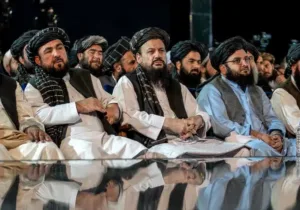For Augustine, peace—defined as the presence of justice, not merely the absence of violence—is the ultimate goal of a just war. It is this pursuit of justice that permits actors with legitimate authority to engage in the use of force out of neighbor love with the goal of establishing the good and punishing evil. But in an age where the lines of warfare are increasingly blurred and the costs of conflict are ever more diffuse, grey zone conflicts present analytical and moral challenges to strategists and just war thinkers alike. Ongoing conflicts in Ukraine, the South China Sea, and the Arctic demonstrate the salience of grey zone conflicts to security studies scholars. While a growing literature addresses the strategic elements of grey zone conflicts, there is virtually no discussion within the just war literature as to how to apply just war thinking to grey zone conflicts. This article seeks to initiate a conversation on just war in the grey zone by presenting a justification for thinking about grey zone conflicts in terms of just war theory and laying out an initial foray into just war thinking about the grey zone.
Conceptualizing the Grey Zone
The Correlates of War dataset, commonly used by political scientists in the study of interstate conflict, defines war as a conflict in which at least one thousand battle deaths occur in a given year. This presents a useful operationalization for some forms of conflict but omits a wide range of conflictual behavior. For Carl von Clausewitz, the application of force was a spectrum ranging from peaceful diplomacy to conventional warfare. War was simply the “continuation of politics by other means.” For Sun Tzu, the “acme of skill” is demonstrated in subduing “the enemy without fighting.” In both strategists, we see a more fluid view of conflict than the simplistic binary of “war” and “peace.”
Discussions of grey zone operations seek to capture more of this spectrum by recognizing a range of low-intensity conflictual behaviors as exercises in the use of force for political ends. These exercises, ranging from faits accomplis in the South China Sea and Russian mercenaries operating in Ukraine to offensive cyber operations, seek to leverage the costs of war as a deterrent, at once applying coercive pressure against their targets while remaining beneath the traditional thresholds of casus belli for retaliatory actions. Seen in this context, grey zone operations represent a crucial tool of “strategic gradualism,” or measured attempts to revise the status quo without provoking outright war.
It is important to note that grey zone operations are not anomalies in the international system. They are ubiquitous. John Chipman notes with concern the rise over the past decade of gray zone strategies with special attention to Russian and Chinese faits accomplis, but suggests these are relatively new phenomena in international politics. Daniel Altman’s research demonstrates that, contrary to popular assumption, states are far more likely to use faits accomplis than coercion to force revisions to the status quo in territorial disputes. Between 1918 and 2015 states used faits accomplis to seize territory in 105 territorial disputes, while only using coercive threats in 12 cases.
Why Consider Just War in the Grey Zone?
Grey zone conflicts may present an interesting analytical puzzle for theorists of international relations, but why should we seek to apply the moral lens of just war thinking to the phenomenon? In short, grey zone operations deserve our attention because they present a challenge to the framework for traditional thinking of just war. Authoritarian states bent on revising the international liberal status quo in their favor are waging a campaign of grey zone operations around the world, employing “strategic gradualism” to revise the global order into one that is both less just and increasingly hostile to American interests. China’s series of faits accomplis in the South China Sea present clear threats to the security of our democratic allies and security partners in the region. Russia’s incursion in Ukraine has hobbled a European security partner and made a mockery of America’s commitment to Ukraine’s territorial sovereignty. Cyber operations by both China and Russia threaten to expose key national security secrets and undermine public confidence in core democratic institutions.
These operations leverage the logic of just cause and proportionality against their targets by intentionally remaining below the threshold of casus belli for outright war while still inflicting damage on the global status quo and American security interests. The logic of just cause is leveraged because while a given grey zone operation might be detrimental to a just peace, it does not, in and of itself, necessarily justify an outright war to rectify the damage wrought. Similarly, grey zone operations aim to effect piecemeal revisions to the status quo such that war as a response is normally considered disproportionately heavy-handed and reckless. Yet taken together, the effects of grey zone operations amount to major threats both to a just peace and to American security interests. Until strategists and just war thinkers begin to consider how to broaden our conceptions of the jus ad bellum standards, we will remain hostage to hostile actors who are willing to exploit our restraint.
Two Initial Steps
Paul Miller’s conceptualization of a just war against the Islamic State provides one clue toward thinking about just war in the grey zone where peer competitors are the main adversary. In any just war, the goal must be a just peace. This means that just attempts to counter grey zone operations will need to be whole-of-government efforts both to stop ongoing operations that jeopardize a just peace and to deter future attempts at the same. In Ukraine for instance, this means more is needed than simply arming and training our beleaguered Ukrainian partners. It means committing to helping build a resilient democratic Ukraine that is both physically secure and ripe for human flourishing. In the South China Sea, it means not only reinforcing our allies against Beijing’s aggression in the region, but shoring up faltering democratic institutions in the Philippines and bolstering norms and institutions that encourage interdependent, independent, and vibrant states.
Another clue lies in the very logic employed in grey zone tactics I outline above. In countering grey zone operations, we need to consider relaxing the just cause standard and reconceptualizing our standards of proportionality. These standards make sense when considering the evils visited on the innocent by warfare: death, privation, and general suffering. They make less sense in the grey zone of cyber conflict, low-intensity conflicts, and salami-slicing land grabs. In this zone, we need a more relaxed standard of just cause that will enable proportionate responses to tactics and strategies that do not meet the traditional standards of just cause. Strategists have been discussing such tit-for-tat responses for years, but just war thinking has not caught up with the cutting edge of strategic thinking to provide a clear just cause standard for sub-war conflicts. Eric Patterson notes that “self-defense of citizens’ lives, livelihoods and way of life” are typical just causes, and that attempts to right wrongs associated with these values are generally considered just. Yet few would conscience an American declaration of war against China to defend the livelihood of the Philippines fishermen deprived of their livelihood by China’s island-grabbing campaign. Instead, under a more relaxed framework, we might say that a counter campaign of cyber operations designed to punish Beijing for its seizures and deter future faits accomplis might be appropriate. Alternatively, another might argue in favor of an extended freedom of navigation operations campaign in which American vessels interpose themselves between threatened fishermen and Chinese Coast Guard ships sent to harass them. The particulars here are less important than the discussion they hopefully generate; the key is that just war thinking needs to consider lower-intensity responses to sub-war operations that threaten a just peace.
This article only scratches the surface of the many important questions that should be raised with regards to just war in the grey zone. Additional questions that other scholars may be interested in taking up include: How should we think about legitimate authority in grey zone conflicts? To what extent are existing jus in bello standards suited to governing grey zone competition? What new problems might be spawned as a result of this proposed revision of just war thinking? There is much more to be said on these questions, but I leave it to further articles (and hopefully other scholars of just war) to address them. However we answer them, it is vital that we begin addressing them together.







 Sponsor a student for Christianity & National Security 2024
Sponsor a student for Christianity & National Security 2024